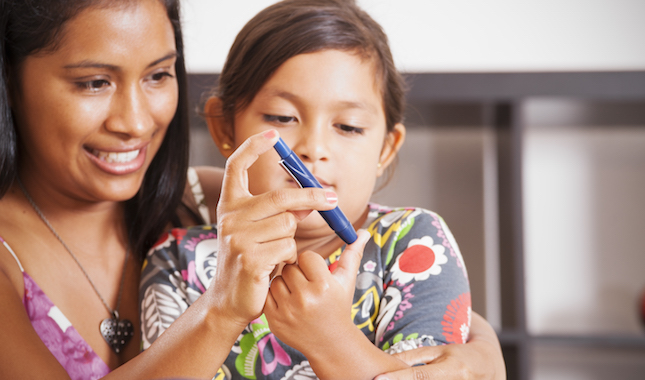Youth Diabetes Is on the Rise, Study Shows
According to the SEARCH for Diabetes in Youth study, diagnosed cases of type 1 and type 2 diabetes in children are increasing. In the United States, 29.1 million people currently live with the condition, with 208,000 patients under the age of 20. This is especially significant for minorities, who saw greater increases overall. MD Now Urgent Care is concerned about the rise of diabetes in children and wants to help the Florida community learn more about the risks.
Five major groups were included in the report: whites (non-Hispanic), blacks (non-Hispanic), Hispanics, Asian Americans and Pacific Islanders, and Native Americans. Researchers found that from 2002 to 2012, diagnosed cases of type 1 diabetes in children increased by 1.8 percent every year. Plus, cases of type 2 diabetes in children increased by nearly 5 percent each year.
Here are some of the report’s key findings:
Across all groups studied, the rate of new diagnosed cases of type 1 youth diabetes increased more in males than females. On the other hand, type 2 diabetes increased much more sharply in females than in males.
- New cases of type 1 diabetes increased the most in Hispanic youth, ages 0–19, followed by non-Hispanic blacks and non-Hispanic whites.
- When it comes to youth ages 10–19, the rate of diagnosed Type 2 diabetes increased most sharply for Native Americans, at 8.9 percent. It’s important to note that this cannot be generalized to all Native American youth across the country.
- The smallest increase in type 2 diabetes among children ages 10–19 was seen in whites, at just 0.6 percent.
When diabetes is diagnosed at an early age, children are more at risk for developing complications. Diabetes can greatly reduce a child’s quality of life, increases family healthcare costs, and can even shorten the child’s life expectancy. With youth diabetes on the rise, it’s more important than ever for parents to learn about the two types of diabetes and their causes.
What Is the Difference Between Type 1 and Type 2 Diabetes?
When you think of a person with type 2 diabetes, you might envision an overweight person who relies on insulin injections. Conversely, you might assume someone suffering from type 1 diabetes will be underweight. These common perceptions aren’t always true; in fact, 20 percent of people with type 2 diabetes were at a healthy weight when diagnosed.
There are several important differences between type 1 and type 2 diabetes in kids. First, type 1 diabetes is often diagnosed in childhood, while type 2 usually doesn’t appear until after the age of 30. Type 1 diabetes in children is not associated with excess body weight; type 2 diabetes can be triggered by obesity. Type 2 diabetes in children often comes with other weight-related problems, including high blood pressure and elevated cholesterol levels.
Both types of diabetes in kids are treated with insulin, which can be administered through injections or a pump. However, early treatment for type 2 diabetes may involve medication or tablets instead of injectables. With diet and exercise, it’s sometimes possible to come off medication for type 2 diabetes.
What Causes Type 1 Diabetes in Children?
The most common type of diabetes in kids, type 1 diabetes, is an autoimmune disease that attacks insulin-producing cells in the pancreas. It is not known why this occurs, but some studies suggest a genetic component. People with type 1 diabetes will always need insulin to compensate for damaged beta cells.
What Causes Type 2 Diabetes in Children?
Unlike type 1 diabetes in children, type 2 diabetes doesn’t involve an autoimmune response. Instead, the body loses its ability to respond to insulin in a condition called insulin resistance. While the pancreas compensates by producing more insulin, it’s not always enough. Over time, the extra insulin damages the beta cells, lowering insulin production. The patient then requires medication or injections to stabilize insulin production.
What Can Parents Do to Prevent Childhood Diabetes?
While type 1 diabetes cannot be prevented, type 2 diabetes can sometimes be avoided through lifestyle changes. Here are a few ways to help your child or teen live a healthy life:
- Encourage children to engage in physical activity every day.
- Make nutrient-rich meals and snacks that taste good.
- Limit servings of sugary, salty, or fat-laden foods.
- Limit screen time to two hours each day.
Remember, both types of diabetes in kids are treatable when monitored by a medical professional. Visit an MD Now Urgent Care center for a free blood glucose check or call your child’s pediatrician if your child displays symptoms of youth diabetes—including excessive thirst, frequent urination, blurred vision, or changes in mood.
To learn more about our urgent care centers, call 888-MDNow-911 or visit www.MDNow.com.
MD Now® Urgent Care Walk-In Medical Centers is the leading provider of fast and affordable urgent care to adults and children in Palm Beach, Broward, and Miami-Dade counties. Our state-of-the-art, walk-in medical centers are open seven days a week to deliver an affordable and convenient alternative to long emergency room wait times and the limited hours of family physicians. No appointment is necessary and major insurance plans are accepted. In addition to providing a comprehensive range of urgent care services to treat a variety of illnesses and injuries, our multiple locations offer digital x-rays, EKG, lab testing, physicals, immunizations, vaccines, occupational medicine, travel medicine and selected primary care services. Find the medical care you need with the convenience you want at MD Now.

